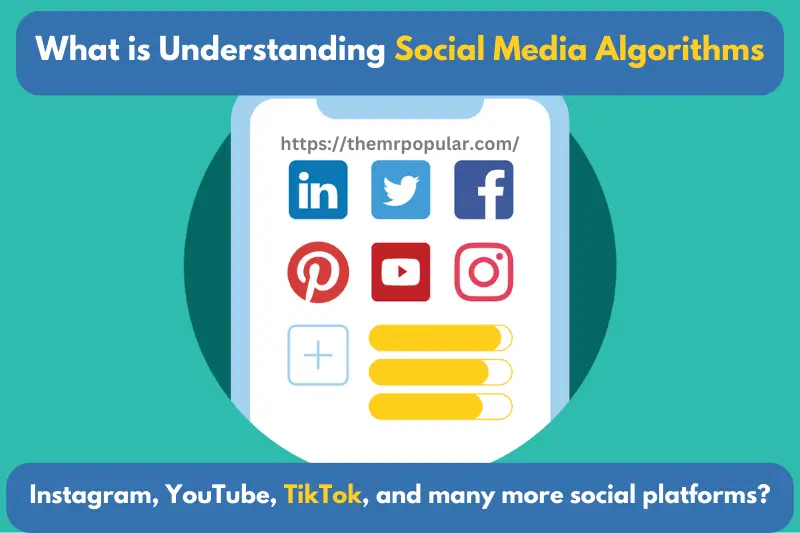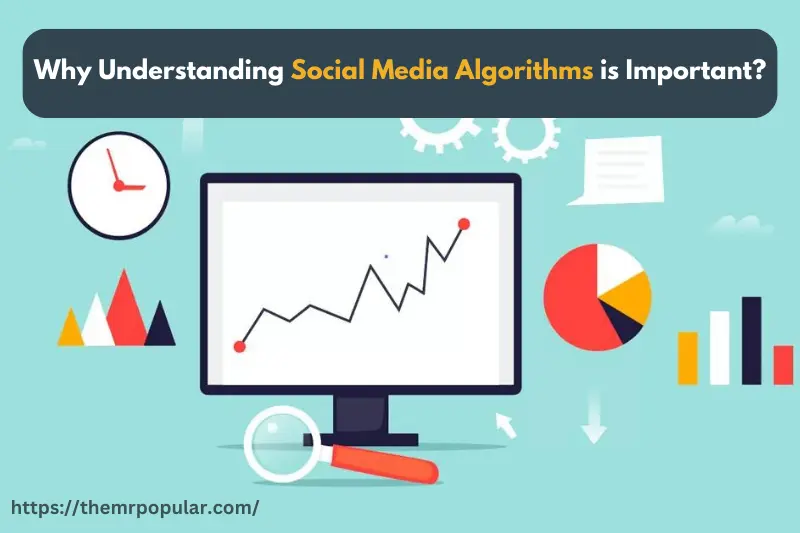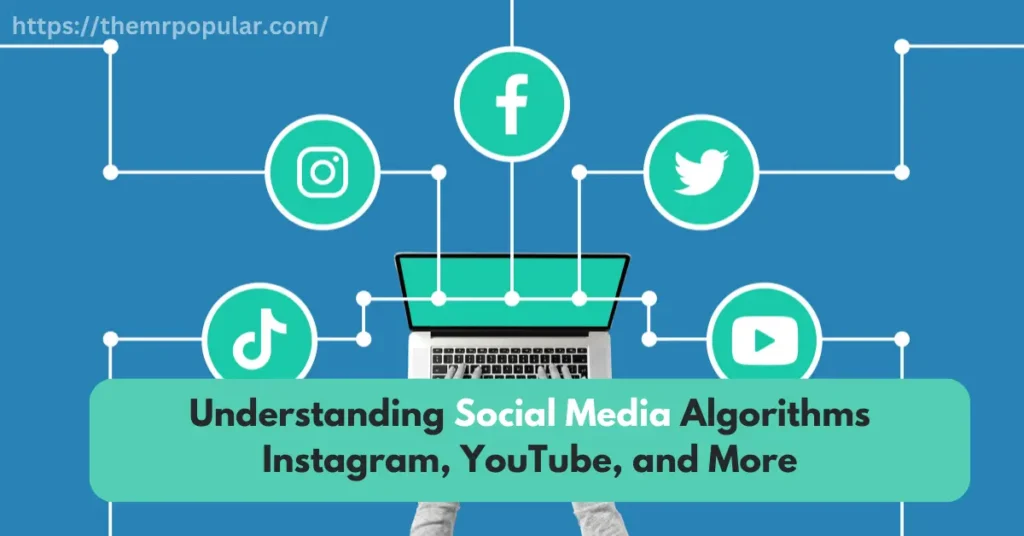Introduction
Social media platforms like Instagram, YouTube, and TikTok seem to know exactly what content to show you, but have you ever wondered how? That’s where algorithms come in. Algorithms are the “rules” or processes that decide what posts, videos, or ads appear on your feed. They help each platform serve content that is most relevant to you based on your behavior, likes, and interests.
In this blog, we’ll break down how the algorithms work on popular platforms like Instagram and YouTube, so you can understand what’s happening behind the scenes and even use it to your advantage. Whether you’re a creator or just curious, learning about social media algorithms will help you navigate these platforms better and make sure you don’t miss out on the content you care about!
What is Understanding Social Media Algorithms: Instagram, YouTube, TikTok, and many more social platforms?

Social media algorithms are the systems that decide what content you see and when you see it on platforms like Instagram, YouTube, and others. These algorithms analyze your behavior—such as the posts you like, the videos you watch, or the accounts you follow—to curate a personalized feed of content. They are designed to show you things that are most likely to keep you engaged, whether that’s a video, post, or advertisement.
By understanding how these algorithms work, you can improve your experience on social media. For content creators and businesses, it’s especially important because it can impact how visible your posts are to your audience. Knowing the key factors that influence these algorithms, such as user interaction, post timing, and content type, helps you create strategies to grow your reach and engagement.
In this article, we’ll take a closer look at the algorithms of major platforms like Instagram and YouTube, highlighting the factors that drive their content ranking systems and tips for making the most of them. Whether you’re looking to expand your social media presence or just curious about how it all works, understanding these algorithms is key!
Why Understanding Social Media Algorithms is Important

Social media algorithms play a huge role in shaping our online experiences. For both everyday users and content creators, understanding how these algorithms work can be a game-changer. Here’s why it matters:
Increased Visibility and Engagement
- For creators and brands: Knowing how to create content that aligns with the algorithm can significantly boost the chances of your posts being seen by more people.
- For users: Understanding the algorithm helps you tailor your experience and ensure that you’re seeing content that matters most to you.
Better Content Strategy
- Target the right audience: Algorithms reward content that resonates with specific users. By learning how these systems work, you can target your audience more effectively and build meaningful engagement.
- Optimize posting times and formats: Algorithms often prioritize certain content formats (like videos on Instagram) or specific times of day when engagement is higher. Knowing these trends will help improve your content strategy.
Stay Ahead of Platform Updates
- Social media platforms frequently update their algorithms. By keeping track of how these changes affect the visibility of your content, you can adapt quickly and maintain your reach.
Maximize ROI for Ads
- If you’re using paid social media advertising, understanding the algorithm ensures that your ads reach the right audience at the right time, optimizing the return on investment (ROI).
Control Over Your Online Experience
- For everyday users: By knowing what factors influence the content you see, you can adjust your behavior (like interacting more with certain posts) to shape a more personalized and relevant feed.
Compete Effectively
- For businesses and influencers: Everyone is competing for attention on social media. A deep understanding of the algorithm helps you stay ahead of competitors by making your content more algorithm-friendly.
- Mastering social media algorithms gives you the tools to grow your online presence, ensure your content reaches the right people, and optimize your overall experience on these platforms.
Step-by-Step Guide: Understanding Social Media Algorithms for Instagram, YouTube, and More
If you’re looking to improve your social media presence or better understand how content gets recommended, here’s a step-by-step guide to help you navigate the algorithms of popular platforms like Instagram and YouTube.
Understand the Purpose of Algorithms
- Why algorithms exist: Social media platforms use algorithms to personalize user experiences and keep them engaged for longer periods. The more you interact with content, the more data the algorithm collects to tailor future recommendations.
- How they work: Algorithms track user behavior—what you like, share, watch, comment on, or save—and use that data to decide which content will appear on your feed.
Key Factors that Influence Algorithms Across Platforms
- Engagement: Likes, comments, shares, and saves show that users are interacting with your content. High engagement signals to the algorithm that your content is valuable.
- Relevance: Content that matches the user’s interests is prioritized. The more your posts or videos resonate with your target audience, the more likely they are to be shown.
- Consistency: Regularly posting content helps the algorithm recognize your profile as active. Being consistent is key to staying visible in users’ feeds.
- Content Format: Certain formats—like videos on Instagram or live streams on YouTube—may be favored by the algorithm because they tend to drive more engagement.
Instagram Algorithm Breakdown
- Feed posts: Instagram prioritizes posts from accounts you frequently interact with. High engagement on your posts (likes, comments, shares) boosts visibility.
- Stories: The more a user engages with your stories, the more likely your stories will appear first on their feed.
- Explore page: This section shows content based on your past activity (posts you liked or accounts you followed). To land here, create highly engaging content that resonates with your followers.
- Reels: Instagram heavily promotes Reels as they compete with TikTok. Use trending music, high-quality visuals, and short, engaging clips to increase your chances of reaching a wider audience.
YouTube Algorithm Breakdown
- Watch time: The more time viewers spend watching your videos, the more likely YouTube’s algorithm will recommend your content.
- Click-through rate (CTR): This measures how often people click on your video after seeing the thumbnail. A higher CTR signals that your content is relevant.
- Video engagement: Likes, comments, shares, and subscriptions are indicators that people are enjoying your videos. Encourage your audience to engage with your content through calls-to-action (CTAs).
- Content optimization: Make use of SEO-friendly titles, descriptions, and tags. YouTube’s algorithm considers keywords to understand what your video is about and show it to relevant users.
- Consistency: Posting regularly and at optimal times helps your videos stay in front of your subscribers and reach new audiences.
Other Social Media Algorithms to Know
- TikTok: TikTok’s algorithm is heavily influenced by video completion rates and engagement. Short, snappy, and engaging content that is watched all the way through has the best chance of going viral.
- Facebook: Facebook’s algorithm gives priority to content that encourages meaningful interactions, like long comments and shared posts.
- Twitter: Twitter’s algorithm prioritizes real-time content but also boosts tweets that receive high engagement, especially retweets and comments.
Tips to Beat the Algorithm
- Post consistently: Posting regularly on Instagram, YouTube, or any platform keeps your content fresh and signals to the algorithm that you’re active.
- Create engaging content: Use eye-catching visuals, compelling titles, and strong calls-to-action to encourage likes, comments, shares, and saves.
- Analyze performance: Use insights and analytics tools on each platform to track how your content performs. Adjust your strategy based on what works best for your audience.
- Follow trends: Stay updated on the latest trends or challenges within your niche to create content that’s timely and relevant.
Keep Up with Algorithm Updates
- Algorithms are constantly evolving, and what works today may not work tomorrow. Stay informed by following platform updates, changes in user behavior, and best practices.
By following this step-by-step guide, you’ll have a solid understanding of how social media algorithms work and how to tailor your strategy for Instagram, YouTube, and other platforms. Whether you’re looking to grow your audience or simply improve your social media experience, understanding these algorithms will help you succeed!
Advantages and Disadvantages of Understanding Social Media Algorithms
Understanding social media algorithms can be a game-changer for individuals, brands, and businesses looking to grow their online presence. However, while there are clear benefits, it’s also important to be aware of the potential drawbacks. Let’s explore both sides:
| ADVANTAGES |
| Improved Content Visibility Knowing how algorithms work helps you create content that is more likely to be seen by your audience. Platforms prioritize content with high engagement, so by tailoring posts to drive interaction, you can increase your visibility on users’ feeds. |
| Audience Growth By understanding what content resonates with your target audience, you can create more tailored, relevant posts or videos. This increases the chances of your content being shared, leading to greater reach and follower growth. |
| Better Engagement Algorithms often reward content that sparks meaningful interactions, such as comments, likes, and shares. Focusing on quality content that engages your audience can lead to a more active community around your brand or profile. |
| Optimized Content Strategy Understanding the algorithm helps you determine the best times to post, which formats to use, and what type of content performs best. This insight allows you to develop a more effective social media strategy, leading to better long-term results. |
| Higher ROI on Advertising If you use paid ads on platforms like Instagram or YouTube, knowing how their algorithms prioritize content will help you target your ads more effectively. This can help maximize the return on investment (ROI) of your social media ad campaigns. |
| Stay Competitive Social media is highly competitive. By understanding the algorithms, you can stay ahead of the curve and position yourself better than others who might not be leveraging this knowledge. For businesses and influencers, this knowledge is crucial for maintaining or improving their online presence. |
| DISADVANTAGES |
| Constantly Changing Algorithms Algorithms on platforms like Instagram, YouTube, and TikTok are frequently updated. What works today might not work tomorrow. It can be challenging to stay on top of these changes, and strategies that were once effective might become outdated. |
| Time-Consuming Learning and adapting to the intricacies of each platform’s algorithm can be time-consuming, especially if you are managing multiple social media accounts. Regularly analyzing your performance data, tweaking your content strategy, and following algorithm updates can require a lot of effort. |
| Pressure to Create Algorithm-Friendly Content To satisfy the algorithm, creators may feel pressured to produce content that fits into specific formats or trends, even if it’s not aligned with their brand or style. This could lead to burnout or a lack of creativity as creators focus more on what the algorithm favors rather than authentic content. |
| Algorithmic Bias Social media algorithms are designed to prioritize engagement, which may unintentionally promote content that is controversial or divisive. This can create challenges for creators who focus on niche content, as their posts may be deprioritized in favor of more widely engaging material. |
| Unequal Playing Field Established creators and brands with large followings often benefit more from algorithms since they naturally generate higher engagement. New or small accounts may find it harder to break through, as they need to work harder to generate the engagement needed to get noticed by the algorithm. |
| Unpredictable Reach Even when you understand the algorithm, there is no guarantee of success. Posts might perform differently due to algorithmic randomness, making it difficult to predict exactly how well a particular piece of content will perform. This unpredictability can be frustrating, especially for brands and creators who depend on consistent results. |
Common FAQs About Social Media Algorithms
You probably have a few questions if you’re new to understanding how social media algorithms work. Here are some of the most frequently asked questions, answered in simple and easy-to-understand terms.
What is a social media algorithm?
Social media algorithm is a set of rules that platforms like Instagram, YouTube, or TikTok use to decide what content you see in your feed. These algorithms analyze your behavior, such as what posts you like or videos you watch, and use that information to show you content you’re most likely to enjoy.
How does the Instagram algorithm work?
Instagram’s algorithm looks at how you interact with posts (likes, comments, shares, and saves) and who you follow or message frequently. It then shows you posts and stories from people or brands you engage with most. It also promotes new content in your Explore and Reels tabs based on what Instagram thinks you’ll find interesting.
How does YouTube’s algorithm decide which videos to recommend?
YouTube’s algorithm prioritizes videos based on watch time, click-through rate (how often people click on your video), and engagement (likes, comments, shares). If a lot of people are watching and engaging with your video, YouTube is more likely to recommend it to others.
Why is it important to understand these algorithms?
Understanding algorithms helps you create content that performs better on social media. If you know what types of content the platform favors, you can increase your chances of reaching more people, growing your audience, and boosting engagement.
Do algorithms favor certain types of content?
Yes, some platforms favor specific types of content. For example, Instagram is currently pushing Reels more than regular posts, and YouTube prioritizes videos with longer watch times. Understanding these preferences can help you choose the best format for your content.
How often do social media algorithms change?
Algorithms change quite frequently as platforms update them to improve user experience. This means what works today may not work tomorrow. It’s important to stay informed about changes, either by following platform updates or by regularly testing new content strategies.
Can I “beat” the algorithm to get more views or likes?
While there’s no magic formula to beat the algorithm, you can improve your chances by creating high-quality, engaging content, posting consistently, and staying active on the platform. Understanding what the algorithm values—such as engagement and relevance—can help you optimize your content for better results.
Why is my content not getting seen, even though I follow the best practices?
It could be for a few reasons:
Competition: There’s a lot of content out there, so it’s possible your posts are getting buried.
Engagement: The algorithm may not be pushing your content if it’s not getting much engagement right away.
Inconsistent posting: If you’re not posting regularly, the algorithm may not prioritize your content.
Keep experimenting and refining your strategy. Sometimes it takes time for things to pick up.
Is it harder for new accounts to get noticed?
Yes, new accounts may struggle initially because the algorithm prioritizes accounts with more engagement. However, by posting consistently, engaging with others, and creating content people want to interact with, you can grow your visibility over time.
How can I stay up-to-date on algorithm changes?
You can stay updated by:
Following official social media blogs (e.g., Instagram’s blog, YouTube Creators).
Watching tutorials and guides from social media experts.
Regularly checking your analytics to see what type of content is performing well and what isn’t.
By understanding and adapting to social media algorithms, you can create a more effective strategy, boost your content’s reach, and grow your presence online!
Bonus Points for Mastering Social Media Algorithms
Here are a few extra tips to give you an edge when working with social media algorithms:
- Use Hashtags Wisely: On platforms like Instagram, relevant hashtags can help the algorithm categorize your content and show it to the right audience. Don’t overdo it—stick to a few highly relevant ones.
- Create Shareable Content: Algorithms love content that gets shared. The more your post is shared, the more it’s likely to be boosted in others’ feeds.
- Collaborate with Others: Partnering with influencers or creators can introduce your content to new audiences, boosting engagement and visibility.
- Use Platform-Specific Features: Each platform promotes its latest features (like Instagram Reels or YouTube Shorts). Using these features can help you get more exposure.
- Encourage Conversations: Posts that spark meaningful conversations—where people leave thoughtful comments or replies—tend to perform better, as algorithms prioritize content that fosters interaction.
By applying these bonus points, you can increase your chances of thriving in the algorithm-driven world of social media!
Conclusion
Understanding social media algorithms is key to making the most of platforms like Instagram, YouTube, and others. By learning how these systems work, you can create content that stands out, boosts engagement, and reaches a wider audience. While algorithms can change, focusing on creating engaging, high-quality content and staying consistent will help you succeed in the long run. Keep experimenting, stay updated on trends, and you’ll be on the right track!
